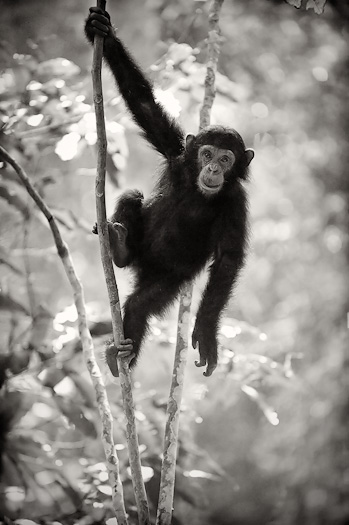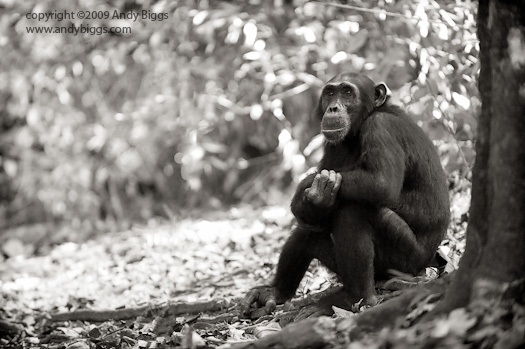Mahale Mountains National Park (Part 3 of 3)
 Thursday, May 13, 2010 at 06:41AM
Thursday, May 13, 2010 at 06:41AM Today we did the same morning routine again, and again went out on our morning hike with the chimpanzees after breakfast. The hike was much longer today, and I think we were gone around 4 to 4.5 hours. In the whole scheme of what these hikes could be, it was certainly middle of the road. The forest behind our camp is quite dark with dappled light coming through, and this is very difficult for photography. One has to pay attention to every little light source, and hopefully one of those light sources can help illuminate a dark face.
I decided to take my D700 instead of my D300, primarily because I was wanting to shoot higher than ISO 1600. My shutter speeds from my first attempt weren't quite what I would want, so I took the risk that my subjects would be closer to me and I could get close to filling the frame at 200mm. Technically we are not allowed to be closer than 10 meters away, however the chimpanzees make the rules in the jungle and they would come close to us after we had stopped at the 10 meter point.
Here are some photos from the day:

Nikon D700, 70-200mm f/2.8 VR, 1/200 @ f/2.8, ISO 3200

Teddy
Nikon D700, 70-200mm f/2.8 VR, 1/1250 @ f/2.8, ISO 5000

The Thinker
Nikon D700, 70-200mm f/2.8 VR, 1/400 @ f/2.8, ISO 4000

A Walk In The Forest
Nikon D700, 70-200mm f/2.8 VR, 1/1000 @ f/2.8, ISO 5000

Nikon D700, 70-200mm f/2.8 VR, 1/320 @ f/2.8, ISO 6400

Nikon D700, 70-200mm f/2.8 VR, 1/800 @ f/2.8, ISO 6400

'Chimping' wild animals in the forest
Nikon D700, 70-200mm f/2.8 VR, 1/640 @ f/5, ISO 6400
Today's light was technically better than on our first hike with the chimpanzees, as it was more overcast. The challenge was that I easily lost at least 2 stops of light because of it. I was very very happy that I chose to bring my D700 instead of the D300, and when I go back to Mahale I will definitely take the best low light camera in my bag. I would rather have better pixels at the same ISO or be able to push it higher, even if it means cropping. Fewer pixels that are better will definitely trump the larger file sizes.
My time at Mahale was a magical one. I had amazing travelers/customers who I absolutely loved spending my time with, the setting along the shores of Lake Tanganyika were otherwordly, and at the top of my list was spending time with the largest free-living colony of chimpanzees on the planet. It isn't for everyone, however I am now hooked on photographing primates in the wild. Large primates. Chimpanzees have human qualities in many things that they do, and it is easy to bond with them (this only goes 1 way, as they don't really regard us when were were there).
Highly recommended. Greystoke Mahale is a location that isn't to be missed.
 Chimpanzee,
Chimpanzee,  Greystoke,
Greystoke,  Mahale,
Mahale,  Tanganyika,
Tanganyika,  Tanzania in
Tanzania in  Safaris
Safaris 



Reader Comments (6)
Just wondering...why the surgical masks???
Thanks for sharing your adventure...I want to do this someday!!! And now I want a D700 too!
Surgical masks are required to prevent the transmission of disease between humans and the chimpanzees.
Very nice images Andy-Love the B/W!
Wonderful low light photography and literally no noice. Very nice Andy!
Andy, what beautiful images of Chimps you are showing there! Amazing. I don't know if I should say "they look so human" or rather say "we kinda look like Chimps"... Keep up your great work which is a source of great inspiration for mine. Thank you for sharing!
Love the picture of the chimp pulling a smug face! (2nd to last one)